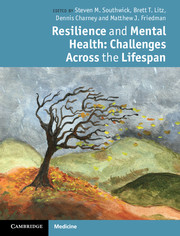Book contents
- Frontmatter
- Contents
- Contributors
- Preface
- Section 1 Pathways to resilience
- Section 2 Resilience across the lifespan
- Section 3 Resilience in families, communities, and societies
- Section 4 Specific challenges
- 13 Loss and grief: the role of individual differences
- 14 Reorienting resilience: adapting resilience for post-disaster research
- 15 Rape and other sexual assault
- 16 The stress continuum model: a military organizational approach to resilience and recovery
- 17 Resilience in the face of terrorism: linking resource investment with engagement
- 18 Resilience in the context of poverty
- 19 Resiliency in individuals with serious mental illness
- Section 5 Training for resilience
- Index
- References
14 - Reorienting resilience: adapting resilience for post-disaster research
from Section 4 - Specific challenges
Published online by Cambridge University Press: 07 September 2011
- Frontmatter
- Contents
- Contributors
- Preface
- Section 1 Pathways to resilience
- Section 2 Resilience across the lifespan
- Section 3 Resilience in families, communities, and societies
- Section 4 Specific challenges
- 13 Loss and grief: the role of individual differences
- 14 Reorienting resilience: adapting resilience for post-disaster research
- 15 Rape and other sexual assault
- 16 The stress continuum model: a military organizational approach to resilience and recovery
- 17 Resilience in the face of terrorism: linking resource investment with engagement
- 18 Resilience in the context of poverty
- 19 Resiliency in individuals with serious mental illness
- Section 5 Training for resilience
- Index
- References
Summary
Introduction
The past few years have seen an increase in research interest about resilience after specific traumatic events. One of the more interesting developments in the peer-reviewed literature about the topic is a broadening of the term “resilience,” extending it from its original formulation pertaining to individual experiences and individual reactions (Bonanno, 2004; Butler et al., 2007; de Mel et al., 2008; Ganzel et al., 2008) to considerations of populations or groups who collectively experience traumatic events (Bruneau et al., 2003; Kendra & Wachtendorf, 2003; Vale & Campanella, 2005; Norris et al., 2008). This chapter focuses on the particular challenges that arise when considering resilience of communities in the context of collectively experienced traumatic events, typically called disasters. This extension is referred to as a “multilevel” conception of resilience, recognizing that in this formulation resilience is both an “individual level” and a “community level” phenomenon.
Although the term disaster represents a broad range of human experiences, disasters have in common their disruption of collectively experienced normal life. This chapter first briefly introduces disaster public health research before going on to discuss the origins and application of resilience as a multilevel concept. A perspective is offered on the meaning and uses of resilience in disaster research and the challenges of applying the concept of multilevel resilience to disaster settings. This is followed by a brief review of the special challenges disasters pose across the multiple levels of human organization – from the molecular to the ecological. Finally, resilience is reoriented in terms of disasters and future research directions are suggested within this rapidly evolving and dynamic concept.
- Type
- Chapter
- Information
- Resilience and Mental HealthChallenges Across the Lifespan, pp. 200 - 217Publisher: Cambridge University PressPrint publication year: 2011
References
- 5
- Cited by



